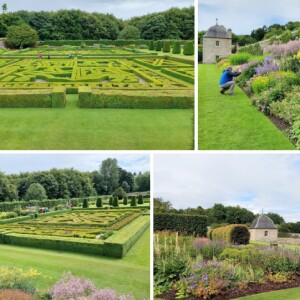A visit to the very colourful Pitmedden Garden produced more sundials for my collection. Pitmedden Garden is a recreation of the spectacular "Great Garden" that was first set up in 1675 by Sir Alexander Seton to accompany his house at Pitmedden. It included large parterres which were very popular at that time. A parterre is a formalised garden usually involving closely clipped hedges and laid out in a symmetrical pattern. Unfortunately the house and all the records were destroyed by fire in 1807. When the National Trust for Scotland took over in 1952 they sought inspiration to recreate the original garden from the 1647 plans for Holyrood Palace in Edinburgh. The design of three of the parterres were used as the basis for three of the parterres with the fourth less formal and the Trust has continued to develop the gardens further bearing in mind modern trends.
There are several sundials including one believed to have been made around 1675 in the centre of the Tempus fugit (‘time flies’) parterre. it features 24 facets and is also thought to be a moon dial, capable of telling the time on strong moonlit nights as well as on sunny days.
Another very old one is on one of the pavilions with three vertical dials carved directly on to the old 17th century building;
A modern one is a human sundial where one stands on the relevant month marked on the central stone and the head or outstretched am shadow lands on one of the stones on the periphery showing the time.
Sundial 39, 40, 41 in my sundial list.

Comments
Sign in or get an account to comment.


